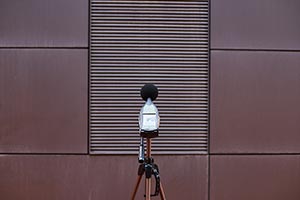What is
STI-PA measurment?
If we analyse speech acoustically, we find that human speech sounds have two characteristics:
- They are in the frequency range from about 100 Hz to 10 kHz
- The intensity of the sounds modulates slowly (between 0.63 and 12.5 Hz)
These modulations of the sound signal generated by a speaker are an important part of the transmission of information in a language. If they are partially lost during transmission, speech intelligibility suffers.
An ITS measurement examines the quality of modulation preservation and presents the result using a modulation transfer function (MTF). The MTF measurements in each octave band indicate how well the modulations have been preserved in each of the different frequency bands, with the modulation ratios (mr) being tested in each octave band. The measurement involves sending, receiving and analysing a synthetic speech signal. The test signal itself is based on pink noise, modulated in seven octave bands with 14 different frequencies. This results in 98 combinations.
The measurement of the 98 combinations, known as the full STI method, is quite complex and difficult to implement in a portable device. However, this method is the most detailed solution for measuring speech intelligibility and is used whenever other approaches do not give reliable results due to unfavourable environmental conditions.
In practice, the Speech Transmission Index for Public Address Systems (STIPA) method is the most widely used. It measures 14 of the combinations and has been specially developed for portable devices.
Our services


The intelligibility of words is especially important when it comes to evacuation systems or announcements in public places such as stations, airports, stadiums, concert halls, but it is also necessary in any building that has meeting and conference rooms, in auditoriums , in restaurants, cafeterias, etc., and to ensure the accessibility of the messages broadcast over the public address system.
Regarding accessibility, Regulation (EU) No. 1300/2014 of the Commission of November 18, 2014, on the technical specification of interoperability related to the accessibility of the railway system of the Union for people with disabilities and people of mobility reduced, establishes that both stations and trains must have a public address system that guarantees that the spoken information will have a minimum STI-PA level of 0.45
The STI-PA parameter, which stands for Speech Transmission Index for Public Address Systems, takes into account the various factors that influence speech intelligibility, such as the quality of the system, the volume of the sound (loud enough, but not too ), the level of ambient noise (crowds of people or road traffic), reverberation (sound reflects off certain surfaces) and psychoacoustic masking effects (a louder sound masks the message).
Discover our other
related services
Why choose Eurocontrol?

a team of experts at your disposal

Geographical coverage nationwide





